What is VR and AR?
Virtual Reality, otherwise known as VR, is a completely digital, simulated experience that could be extremely similar or completely different from the real world. In regards to education, the use of VR in classroom settings has been increasing in popularity over the past few years. According to the article, “How VR In Education Will Change How We Learn And Teach” by Nick Babich, “Virtual reality can be used to enhance student learning and engagement as well as transform the way educational content is delivered.” By creating a virtual world, real or imagined, VR allows students the opportunity to not only see but also interact with educational material. In the classroom, VR can take the form of various technologies including special goggles, or headsets to view 3D simulations.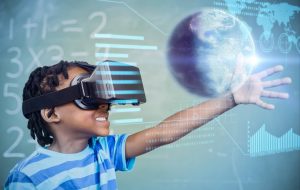
Augmented Reality or AR, is a technology that overlays interactive digital elements, such as text, images, video clips, sounds, 3D models and animations, into real-world environments according to EBSCOpost. In educational settings, AR can be used to enhance communication between teachers and students. Moreover, in the classroom setting, using fixed virtual technology allows students to better visualize complex concepts that would be extremely difficult to comprehend. Although, AR is a relatively new technology in education, it transforms standard education to satisfy the needs of all learners.
When I first found out that we were using VR and AR in my ECI 201 class, I was extremely excited. I never had the opportunity to use this type of technology in educational settings. At first I thought that using the technology would be difficult as I had only seen gamers or scientists use VR googles or headsets. After learning more in my class and using tools that are categorized as VR or AR, I now know how to incorporate them into lessons as a future educator. Through this opportunity, I also was able to realize the importance of enhancing each student’s learning experience through interactive technologies such as AR and VR as they reach multiple types of intelligence and provide students with a different level of interaction. As a result I plan to use AR and VR in my future classroom.
VR and AR in the Classroom
The use of VR and AR technology in the classroom has become increasingly popular in the last few years as there are many benefits to teaching with these types of technologies. Educators can use various softwares and technologies to incorporate VR as well as AR into the classroom. Many teachers have used VR and AR to immerse students in the content they are learning about in various facets of the curriculum.
Enhancing Science Education
VR and AR can be used to enhance science education as students can simulate what they are learning. Moreover, VR and AR can help deepen student’s understanding of subjects such as biology and anatomy, which require students to grasp the inner workings of cells and organs that are not visible to the human eye. For instance, in Belmont, California, high school biology teacher, Rebecca Girard has been using mixed reality computers from zSpace, which come with special glasses that allow cells and organs to “pop out” of the flat screen in 3D. This helps her students gain a better grasp on how the heart works. Using apps like Cyber Science, zSpace Studio, and Human Anatomy Atlas, Girard’s students can follow the path of blood flow through arteries as the heart beats, watching valves open and close. According to an interview in the article, “Will Virtual Reality Drive Deeper Learning“, Girard stated,” Real organs used in dissection are preserved and inflexible, and the valves and muscle no longer pump. I have been teaching biology for 22 years, and I have never had students understand the structures, relationships, and orientations of the organs with the same clarity as when they used virtual reality.”
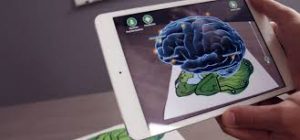
In my ECI 201 class we also used AR and VR tools to better understand scientific topics. For instance, we used an app called Quiver to learn more about the various parts of the cell. First, my instructor printed out a Quiver coloring sheet of a plant cell, which I then colored with markers, making each part of the cell a different color. Once I was done, I launched the Quiver app and scanned my picture. After scanning my picture the app had a 3D image of the plant cell I just colored, and I could click on the various parts of the cell while receiving the name of each part as well as the function. There was also other ways I could interact with the material as there was a quiz as well as a place to label each part of the plant cell. This not only was extremely fun but it was very informative as I was able to really interact with the anatomy of a plant cell.
Although, VR and AR can be used to simulate more complex science topics at higher levels of education, I plan to use various types of VR and AR in the elementary setting. For instance, I plan to use ClassVR a website which has various lessons and topics that are based for elementary students. I could use the preplanned VR lessons to teach my students about topics such as the night sky, the solar system, air transport, and water transport. Through VR, my students would be able to experience these topics in new ways and actually interact with the material as opposed to learning it out of a textbook or class lecture. I think that they would not only be excited to learn more about science but this would also help to better their understanding of scientific topics such as the solar system.
Brining Light to Various Perspectives: Teaching Empathy
VR and AR can also be used to teach students about empathy as it allows students to experience situations of others which they may have never encountered. By showing students, various perspectives of situations or events, they are able to better develop a sense of compassion and concern for others. For instance, Global Nomads, developed the One World, Many Stories program. This program used virtual reality to build connections between 20 classrooms in the United States and the Middle East. Through the program’s use of VR simulations, students were able to walk the streets with a teen in Jordan or Kentucky and be immersed in their day-to-day life, gaining understanding of other cultures and viewpoints along the way. In another program, Embodied Labs provided training for students to become better caregivers for the elderly. Through VR simulation, students were able to experience the medical challenges seniors face. This not only created a better sense of understanding for students who may not fully grasp what the Elderly experience, but allowed the students to develop compassion towards another individual.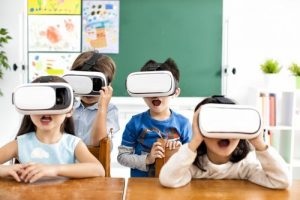
Since I plan on getting a certificate in special education, in the future I want to work in an integrated classroom setting with both general education students as well as intellectually disabled children. I hope to use a VR simulation to help my students accept everyone regardless of ability, and develop compassion for their peers. One way I plan on doing is using ClassVR to have my students experience what it could be like to live with autism. The simulation takes the viewer through the feeling of anxiety, the sensory overload to help them understand how people with ASD might view different situations and how this can lead to certain behaviors. This would offer my students a fresh perspective on the world and other people’s perceptions as well as develop a sense of compassion for others.
New Perspectives on History
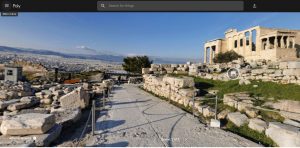
A clip of my Google Tour
VR and AR can bring students back in time to experience historical events right in the classroom! For example, fifth grade teacher, Corey Engstrom, had his students build an early American colony with VR and AR technologies. He had students populate the colony with historical figures, and create buildings inside a virtual world, instead of using clay, cardboard, and glue. Using the platform CoSpaces Edu, the students were able to animate their colonists to buy and sell goods, board merchant vessels, and head out to sea for trade.
I would love to use VR and AR to also enhance my history lessons at the elementary level. In my ECI 201 class, each student was required to make a Google Tour of various locations, which had to include three scenes as well as callouts to better explain what was occurring and the significance of each place. I choose to do my VR tour on a trip I took to Greece over the summer, and I was able to add in information about the historic sites which I visited. I plan on creating and using Google Tours in my future classroom so my students can better understand where historical events occurred. I think this tool is excellent as it allows students the opportunity to become fully immersed in the setting of the tour as well as provide valuable information that can enhance learning.
Additional AR and VR sources
Here are a few additional AR and VR resources for the classroom:
Metaverse– A free platform that allows users to create and share interactive content in augmented reality. Educators can use the tool to gamify learning through warm-up exercises, review games or formative assessments. Students can download the free mobile app to participate in teacher or user created games, location-based experiences, scavenger hunts, geocaching and more.
MERGE Cube– MERGE Cube lets students “hold a hologram” in their hands. Available through popular retailers for about $15, the foam cube features unique designs on each side. When held in front of a device’s camera while using one of MERGE’s apps, the cube transforms into a digital 3D object or scene that can be viewed from different angles by rotating the cube. With a MERGE Cube, teachers can create lessons and activities to explore STEM concepts, illustrate complex systems, and enable students to “experience” history or science.
Catchy Words AR– Great for elementary school settings! This is a free word game that combines learning with movement. Without touching the screen, students walk around “catching” letters with their devices to solve word puzzles.
If you wish to learn about more AR and VR applications click here
Benefits and Drawbacks of using AR and VR in the Classroom
Benefits:
- Visualizing becomes easier for students
- Work doesn’t really feel like work
- Facilitates understanding of complex topics
- Makes it easier for students to contextualize information
- Can directly interact with virtual through manipulation of real objects
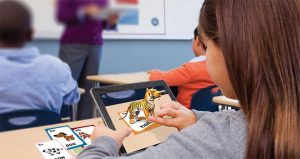
- Can provide out of the classroom learning opportunities
- Active teaching and active learning are both needed/used
- Offers opportunities for collaboration
Drawbacks
- VR and AR are extremely expensive for schools to obtain
- The use of VR and AR deteriorates human connection and social skills
- VR and AR functionality seems to be an issue across educational settings as well as flexibility in lessons
- VR and AR can cause health problems, and many parents are concerned about the long term effects.
Conclusions
Overall, I think virtual Reality and Augmented Reality are becoming increasingly popular as well as useful in education settings. By researching specific softwares, every educator can find ways to incorporate AR or VR into their lessons to make them more engaging and catered towards a diverse group of learners. VR and AR provide students with opportunities they would have never previously experienced by having students interact with material that relates to what they are learning in school. For instance, if students are learning about the solar system, they can use VR and AR to visualize and interact with each planet, all while having fun. Therefore, AR and VR can be considered the perfect learning tool for students as they can learn while interacting with various materials in a new engaging way.
As an elementary education major, I can see the advantages of using VR and AR in my classroom. Despite some of the drawbacks including health and parent concern, I plan on limiting my students use of VR and AR technology so they do not become ill or spend too much time on screens. However, I do plan on incorporating VR and AR softwares into various disciplines as I believe that they are the perfect way to reach all types of learners, and allow the students to have a fun interactive experiences to further their knowledge. As I mentioned before I plan on using technology such as ClassVR to further enhance my student experiences with various science lessons, and to teach my student’s important moral lessons such as developing empathy for others. I also plan on using Google Tour as it will provide my students the opportunity to discover various historical or global locations from the comfort our classroom. Overall, I think VR and AR use will increase in the classroom in the next few years and I cannot wait to further develop lessons with this technology.